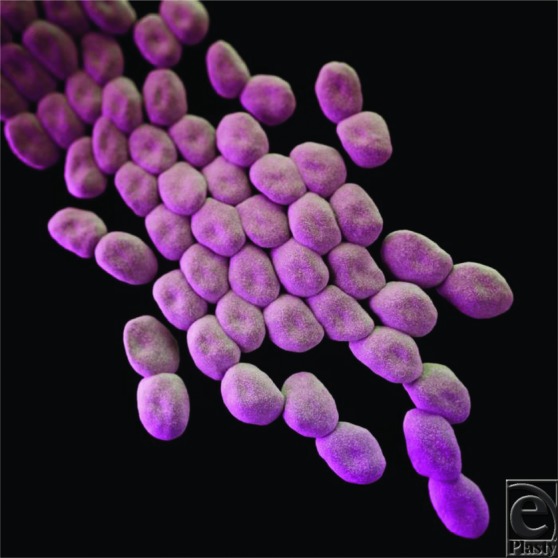
DESCRIPTION
A 56-year-old woman with previous breast cancer underwent a muscle-sparing transverse rectus abdominis myocutaneous flap to her left breast. She developed marked flap swelling postoperatively and episodes of pyrexia.
A breast wound swab grew Escherichia coli and Acinetobacter baumannii. This strain of Acinetobacter was multidrug resistant, including resistance to meropenem.
QUESTIONS
What is Acinetobacter and how common is Acinetobacter infection?
How dangerous is Acinetobacter infection?
How is it diagnosed?
What precautions do you need to take and how do you treat it?
DISCUSSION
Acinetobacter is a pleomorphic aerobic gram-negative bacillus, increasingly found in hospitalized patients. Isolates from patients usually reflect colonization as opposed to infection. However, when the organism is pathogenic, it can be multidrug resistant and therefore difficult to treat. Acinetobacter infections rarely occur outside of health care settings but may occur in tropical environments, wars, and natural disasters. Its natural environment includes water and soil. In the hospital setting, it is most commonly found on the intensive care unit and burns units. In human populations, it colonizes the respiratory and gastrointestinal tracts, skin, and wounds. Some strains can survive in iron-deficient and dry environments for months, leading to the increased risk of fomite contamination.1 It is estimated to be the cause of 2% to 10% of all gram-negative infections in intensive care units in both the United States and Europe.2
Acinetobacter has low virulence but can cause infection in those who are immunocompromised, have chronic disease, have surgical wounds, or have prolonged hospital admissions. Infections caused by Acinetobacter can include bacteremia, hospital-acquired pneumonia, meningitis, and urinary tract infections.3 It can contaminate traumatic and surgical wounds, causing soft-tissue infection and osteomyelitis. Infections from Acinetobacter baumannii are renowned for being difficult to treat due to its antimicrobial resistance. This is in part due to its effectiveness in acquiring genetic material from other organisms and therefore rapidly developing drug resistance.4 A number of strains incorporate a polysaccharide capsule that may stop complement activation and protect against phagocytosis from macrophages.5 The species also form biofilms to adhere to environmental surfaces.6
Diagnosis can be achieved through taking appropriate samples for culture such as wound swabs or blood. In outbreaks, it is easy to culture Acinetobacter from monitors and equipment around the colonized patient. It is therefore paramount to thoroughly clean the ward and operating room the patient has been in. Microbiologically, it is nonmotile, catalase-positive, and oxidase-negative. In standard cultures, it appears as broad, short, gram-negative rods in rapid growth phase but a more coccobacillary shape in stationary phase. They do not reduce nitrate or ferment glucose.7
Those proven to be colonized with Acinetobacter should be isolated and appropriate infection control measure put in place. Supportive care includes removing or replacing any lines, catheters or drains. Regular discussion with Microbiology needs to take place to define colonization versus infection, as well as appropriate antibiotic regimens. Antibiotics used include meropenem, tigecycline, minocycline, colistin, amikacin, rifampin, and polymyxin B. Combination therapy may be required. Most infections, until recently, were sensitive to the carbapenems, but cases of resistance have been increasing. Multidrug-resistant Acinetobacter is commonly susceptible to antiseptic and disinfectants. Reports of failure to contain the bacteria are more likely due to staff not following correct cleaning procedures than to do with disinfectant resistance. Control of the outbreak is more likely to occur when the source is identified and eliminated. Hydrogen peroxide vapor can also be used as an effective mode of decontamination.8
In conclusion, Acinetobacter baumannii can be found as a colonizing bacterium with no adverse effects. However, it can be contaminated easily within a hospital or battlefield environment, and when it becomes an infective organism, it may be difficult to treat, as multidrug resistance is common. Those who are immunocompromised, have chronic disease, have surgical wounds, or have prolonged hospital admissions are particularly vulnerable. When a patient is proven to be colonized with Acinetobacter, the patient should be isolated and appropriate infection control measure put in place to prevent colonization or infection of other patients.
REFERENCES
- 1.Kanafani ZA, Kanj SS. Acinetobacter infection: epidemiology, microbiology, pathogenesis, clinical features, and diagnosis. UpToDate. [serial online]. 2014. Available at: http://www.uptodate.com/contents/acinetobacter-infection-epidemiology-microbiology-pathogenesis-clinical-features-and-diagnosis?source=machineLearning&search=acinetobacter+baumannii&selectedTitle=2%7E60§ionRank=1&anchor=H688208535#H688208535. Accessed January 2, 2016.
- 2.World Health Organization. Multidrug-resistant Acinetobacter baumannii (MDRAB) 2010. Available at: http://www.wpro.who.int/mediacentre/factsheets/fs_20101102/en. Accessed February 4, 2016.
- 3.Eliopoulos GM, Maragakis LL, Perl TM. Acinetobacter baumannii: epidemiology, antimicrobial resistance, and treatment options. Clin Infect Dis. 2008;46(8):1254–63. doi: 10.1086/529198. [DOI] [PubMed] [Google Scholar]
- 4.Kramer A, Schwebke I, Kampf G. How long do nosocomial pathogens persist on inanimate surfaces? A systematic review. BMC Infect Dis. 2006;6(1):1. doi: 10.1186/1471-2334-6-130. [DOI] [PMC free article] [PubMed] [Google Scholar]
- 5.Russo TA, Luke NR, Beanan JM, et al. The K1 capsular polysaccharide of Acinetobacter baumannii strain 307-0294 is a major virulence factor. Infect Immun. 2010;78(9):3993–4000. doi: 10.1128/IAI.00366-10. [DOI] [PMC free article] [PubMed] [Google Scholar]
- 6.Tomaras AP, Dorsey CW, Edelmann RE, Actis LA. Attachment to and biofilm formation on abiotic surfaces by Acinetobacter baumannii: involvement of a novel chaperone-usher pili assembly system. Microbiology. 2003;149(12):3473–84. doi: 10.1099/mic.0.26541-0. [DOI] [PubMed] [Google Scholar]
- 7.Peleg AY, Seifert H, Paterson DL. Acinetobacter baumannii: emergence of a successful pathogen. Clin Microbiol Rev. 2008;21(3):538–82. doi: 10.1128/CMR.00058-07. [DOI] [PMC free article] [PubMed] [Google Scholar]
- 8.Villegas MV, Hartstein AI. Acinetobacter outbreaks, 1977-2000. Infect Control Hosp Epidemiol. 2003;24(04):284–95. doi: 10.1086/502205. [DOI] [PubMed] [Google Scholar]


